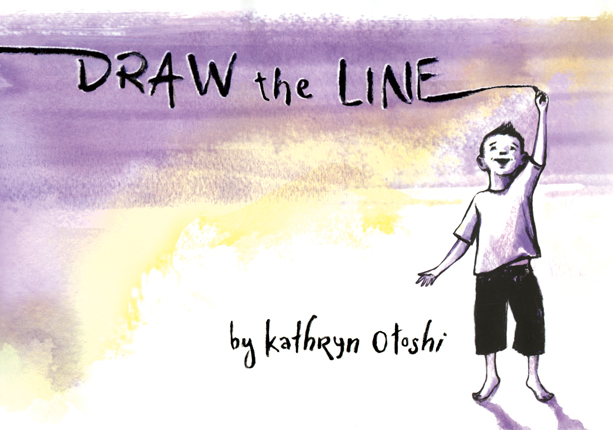| Draw the line Author: Otoshi, Kathryn | ||
| Price: $23.78 | ||
Summary:
Two boys learn about imagination and play as well as conflict and forgiveness through simply drawing a line.
Reviews:
Kirkus Reviews (+) (08/01/17)
School Library Journal (+) (10/01/17)
Booklist (09/01/17)
Full Text Reviews:
Booklist - 09/01/2017 Otoshi packs a powerful message into a short series of wordless images. Two young boys with differing skin tones peacefully draw lines on the ground. Coming from opposite directions, they back into each other. Realizing neither meant harm, they join their lines and magically lift them off the ground, turning the lines into a rope. Conflict erupts, however, and the rope frays, then splits, and then opens into a deep chasm. The more the boys argue, the larger the distance between them grows. Eventually they come to a place where they are able to bridge the gap, but must actively work together to do so. What looks like pastels and watercolors are used throughout the simple illustrations to reflect changes in mood and emotion. When the boys are happy, hints of yellow surround them. Purple, which darkens to black, emphasizes their anger. While young children can easily follow the straightforward message about conflict resolution, older children and adults will find discussion material about the difficult issues that can divide friends, families, groups of people, or even countries. - Copyright 2017 Booklist.
School Library Journal - 10/01/2017 PreS-Gr 2— Two boys have their backs to each other as they draw lines on the ground. When they run into each other, they decide to join their lines. One boy picks up the line, which has turned into a string, and starts playing with it. The other boy thinks this is funny—until the string gets caught around him and yanks him off his feet. Then he is angry, especially since the other boy laughs. He gets up and deliberately tugs on the string, yanking the laughing boy off his feet. The string starts to fray as the conflict between them escalates. As the boys yank back and forth on the string, the fraying part gets bigger and bigger until a chasm has opened up between them and the string has hardened. The boys yell at each other for a minute and pout, which causes the space to get even bigger. Eventually, the antagonists calm down, and one boy decides to let go of his anger. He walks back toward the narrower end of the abyss and the other boy follows. He kneels down and draws a bridge over the narrowest part of the cleft, which leads the other boy to kneel down; soon, the children are working together to close the distance. This wordless book uses symbolism to beautifully illustrate the damage that conflict can cause. The growing chasm, along with the mixed colors that clearly capture the boys' feelings (yellow for happy, purple for unhappy) as they fluctuate, is striking. VERDICT This beautiful analogy of conflict resolution is a must-have for all libraries.— Heidi Grange, Summit Elementary School, Smithfield, UT - Copyright 2017 Publishers Weekly, Library Journal and/or School Library Journal used with permission.



